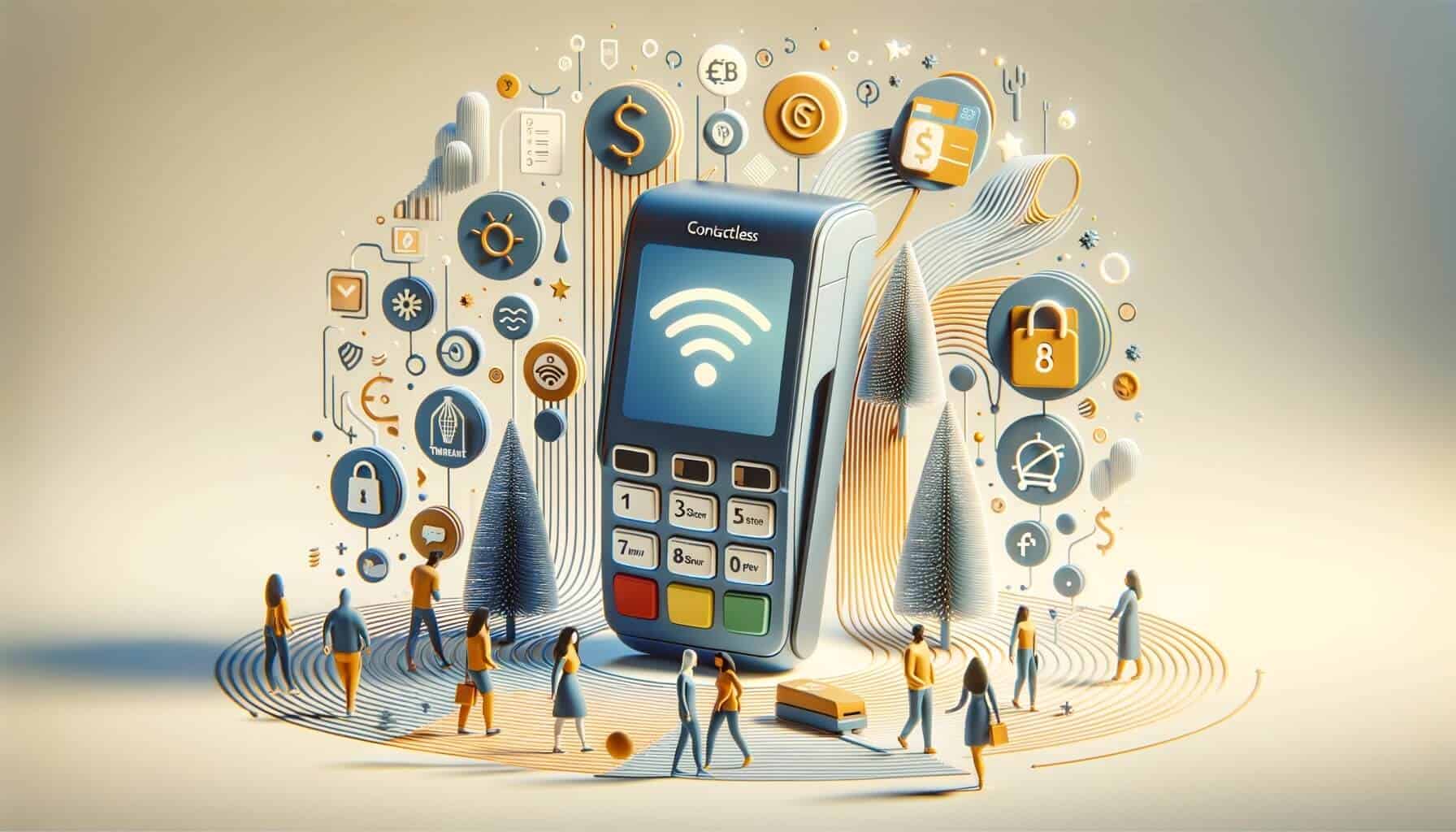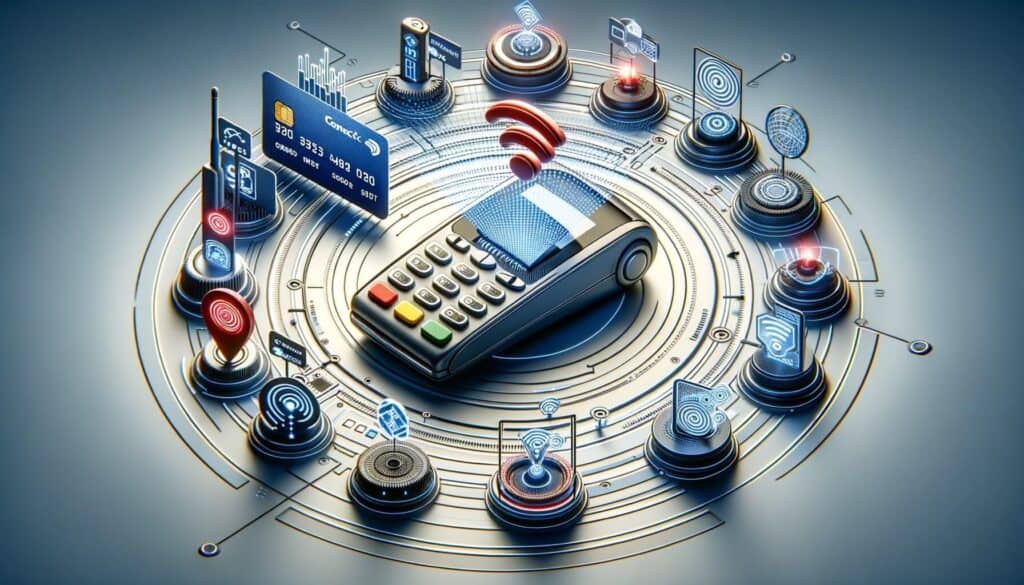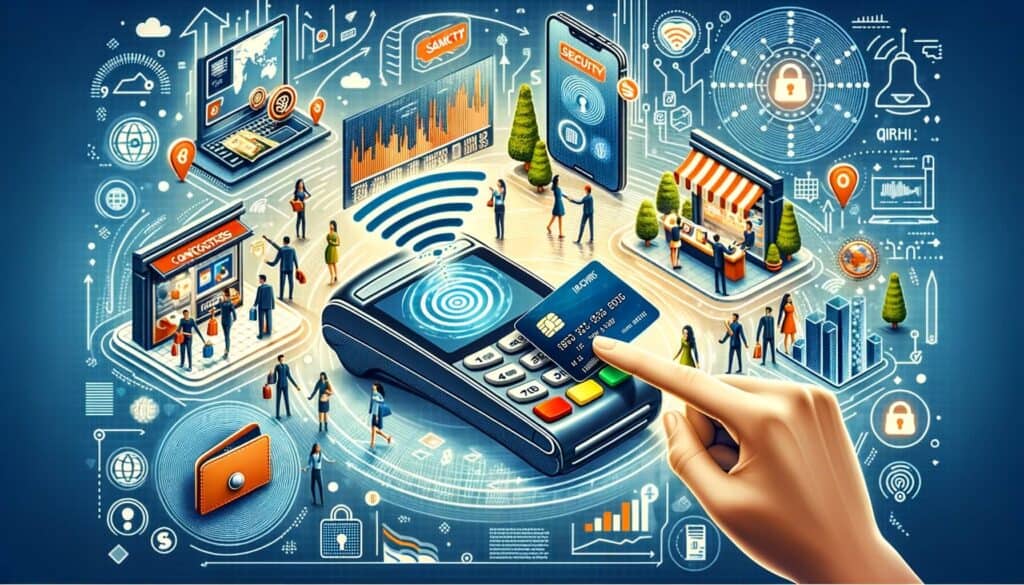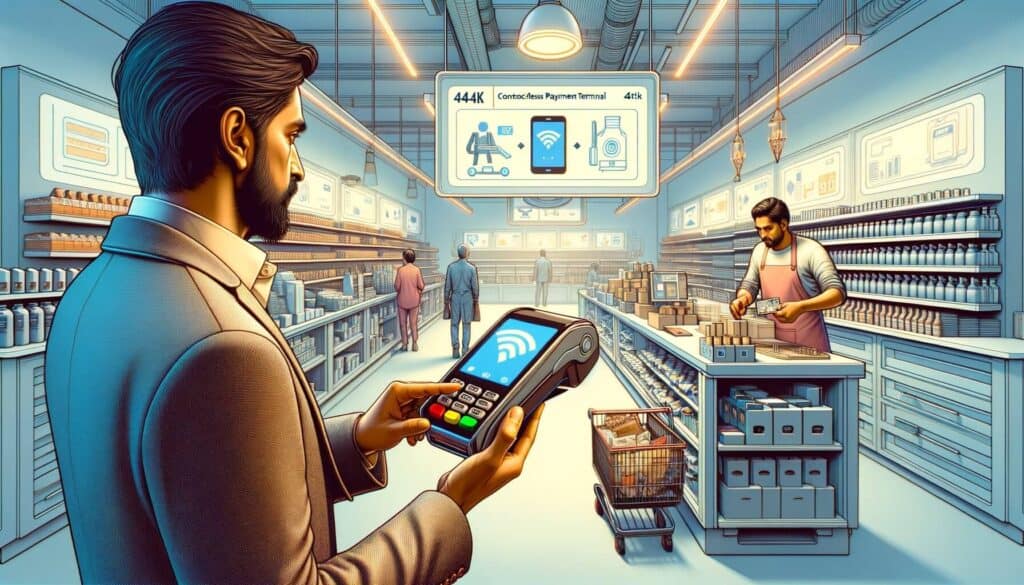
By Harriet Forster March 25, 2025
In today’s fast-paced world, convenience is key. Whether it’s ordering food, shopping online, or paying for goods and services, people are constantly seeking ways to streamline their daily tasks. One such innovation that has revolutionized the payment industry is contactless payment terminals.
These terminals allow customers to make payments quickly and securely by simply tapping their contactless-enabled cards or mobile devices. In this article, we will explore the benefits of contactless payment terminals and how they are transforming the way we make transactions.
How Contactless Payment Terminals Work

Contactless payment terminals utilize near field communication (NFC) technology to facilitate transactions. NFC enables two devices to communicate wirelessly when they are in close proximity to each other, typically within a few centimeters. When a customer taps their contactless card or mobile device on the payment terminal, the NFC chip in the card or device emits a radio frequency signal.
The payment terminal then receives this signal and processes the transaction, deducting the appropriate amount from the customer’s account. This entire process takes just a few seconds, making it significantly faster than traditional payment methods.
Advantages of Contactless Payment Terminals

1. Speed and Convenience: One of the primary advantages of contactless payment terminals is the speed and convenience they offer. With a simple tap, customers can complete their transactions in a matter of seconds, eliminating the need to fumble for cash or wait for chip card transactions to process. This not only saves time for customers but also reduces queues and improves overall customer satisfaction.
2. Enhanced Security: Contactless payment terminals employ advanced security features to protect customer data. Each transaction is encrypted, ensuring that sensitive information such as card details or personal identification numbers (PINs) cannot be intercepted or accessed by unauthorized individuals. Additionally, contactless payments do not require the physical exchange of cards, reducing the risk of card skimming or theft.
3. Increased Spending Limit: Contactless payment terminals often have higher spending limits compared to traditional payment methods. This allows customers to make larger purchases without the need for additional verification or authorization. The convenience of contactless payments encourages impulse buying and can lead to increased sales for businesses.
4. Reduced Need for Cash: Contactless payment terminals contribute to the ongoing shift towards a cashless society. As more people embrace digital payments, the need for carrying physical cash decreases. This not only reduces the risk of loss or theft but also eliminates the hassle of counting and handling cash for both customers and businesses.
5. Versatility: Contactless payment terminals are compatible with a wide range of payment methods, including contactless cards, mobile wallets, and wearable devices. This versatility allows customers to choose the payment method that suits them best, providing a seamless and personalized payment experience.
Enhanced Security Features of Contactless Payment Terminals

Contactless payment terminals incorporate several security features to protect customer data and prevent fraudulent activities. These features include:
1. Tokenization: Contactless payment terminals use a process called tokenization to enhance security. When a customer taps their card or device on the terminal, a unique token is generated for that specific transaction. This token replaces the actual card details, ensuring that sensitive information is not stored or transmitted during the transaction. Even if the token is intercepted, it is useless to fraudsters as it cannot be used for any other transaction.
2. Encryption: All contactless transactions are encrypted, meaning that the data transmitted between the card or device and the payment terminal is scrambled and can only be deciphered by authorized parties. This encryption ensures that even if the transaction data is intercepted, it cannot be read or used to gain access to sensitive information.
3. Two-Factor Authentication: Some contactless payment terminals support two-factor authentication, adding an extra layer of security to the transaction process. This may involve the customer entering a PIN or providing biometric authentication, such as a fingerprint or facial recognition, to authorize the payment. Two-factor authentication reduces the risk of unauthorized transactions in case a card or device is lost or stolen.
4. Fraud Monitoring and Detection: Contactless payment terminals are equipped with sophisticated fraud monitoring and detection systems. These systems analyze transaction patterns and identify any suspicious activities, such as multiple transactions within a short period or transactions from different locations. If any anomalies are detected, the system can trigger alerts or block further transactions, protecting both customers and businesses from fraudulent activities.
Contactless Payment Terminals and Customer Convenience

Contactless payment terminals have significantly improved customer convenience by simplifying the payment process. Here are some ways in which they enhance the overall customer experience:
1. Speed and Efficiency: Contactless payments are incredibly fast and efficient. Customers can complete transactions with a simple tap, eliminating the need to insert cards, enter PINs, or sign receipts. This saves valuable time, especially in busy environments such as retail stores, restaurants, or public transportation.
2. Ease of Use: Contactless payment terminals are designed to be user-friendly, requiring minimal effort from customers. The intuitive interface and clear instructions make it easy for anyone to make a contactless payment, regardless of their technological proficiency.
3. Reduced Need for Physical Contact: In today’s world, where hygiene and safety are paramount, contactless payments offer a touchless alternative to traditional payment methods. Customers no longer need to handle cash or physically exchange cards, reducing the risk of germ transmission. This is particularly important in environments where multiple people handle payment terminals, such as restaurants or retail stores.
4. Seamless Integration with Mobile Devices: Contactless payment terminals seamlessly integrate with mobile devices, allowing customers to make payments using their smartphones or smartwatches. Mobile wallets, such as Apple Pay, Google Pay, or Samsung Pay, store card information securely and enable customers to make payments by simply tapping their devices on the payment terminal. This eliminates the need to carry physical cards and provides a convenient and personalized payment experience.
5. Accessibility for All: Contactless payment terminals are inclusive and accessible to a wide range of customers. They cater to individuals with disabilities or mobility issues who may find it challenging to handle cash or insert cards into traditional payment terminals. The simplicity and speed of contactless payments ensure that everyone can participate in the digital economy without any barriers.
Contactless Payment Terminals and Business Efficiency
Contactless payment terminals not only benefit customers but also offer numerous advantages for businesses. Here are some ways in which they enhance business efficiency:
1. Faster Transaction Processing: Contactless payments significantly reduce transaction times, allowing businesses to serve more customers in less time. This is particularly beneficial in high-volume environments, such as busy retail stores or fast-food restaurants, where long queues can deter potential customers. By speeding up the payment process, businesses can improve customer satisfaction and increase overall sales.
2. Streamlined Operations: Contactless payment terminals integrate seamlessly with existing point-of-sale (POS) systems, enabling businesses to streamline their operations. The integration eliminates the need for manual data entry or reconciliation, reducing the chances of human error and saving valuable time for employees. This automation also minimizes the need for cash handling, reducing the risk of theft or discrepancies in cash management.
3. Enhanced Reporting and Analytics: Contactless payment terminals provide businesses with detailed transaction data and analytics. This information can be used to gain insights into customer behavior, preferences, and spending patterns. By analyzing this data, businesses can make informed decisions regarding inventory management, marketing strategies, and customer engagement, ultimately improving their bottom line.
4. Reduced Costs: Contactless payments can help businesses reduce costs associated with cash handling and processing. Cash management involves expenses such as counting, sorting, and transporting cash, as well as the risk of theft or counterfeit notes. By encouraging customers to use contactless payments, businesses can minimize these costs and allocate resources more efficiently.
5. Integration with Loyalty Programs: Contactless payment terminals can be integrated with loyalty programs, allowing businesses to reward customers for their repeat purchases. By linking contactless payments to loyalty accounts, businesses can offer personalized discounts, promotions, or exclusive offers, fostering customer loyalty and encouraging repeat business.
Contactless Payment Terminals and the Future of Payments
The rise of contactless payment terminals is indicative of the ongoing transformation in the payment industry. As technology continues to advance, we can expect further developments and innovations in the field of digital payments. Here are some trends that highlight the future of contactless payment terminals:
1. Wearable Devices: Contactless payments are no longer limited to cards or smartphones. The emergence of wearable devices, such as smartwatches or fitness trackers, has opened up new possibilities for contactless payments. These devices can be linked to payment accounts, allowing users to make payments by simply tapping their wrists. As wearable technology becomes more prevalent, we can expect to see an increase in contactless payments through these devices.
2. Internet of Things (IoT) Integration: The Internet of Things (IoT) refers to the network of interconnected devices that can communicate and exchange data. Contactless payment terminals can be integrated with IoT devices, such as smart refrigerators, vending machines, or even cars, enabling seamless and secure payments in various contexts. This integration will further enhance the convenience and accessibility of contactless payments.
3. Biometric Authentication: Biometric authentication, such as fingerprint or facial recognition, is becoming increasingly prevalent in various industries. Contactless payment terminals can leverage biometric technology to provide an additional layer of security and convenience. Customers may soon be able to authorize payments using their unique biometric identifiers, eliminating the need for PINs or passwords.
4. Blockchain Technology: Blockchain technology, which underpins cryptocurrencies like Bitcoin, has the potential to revolutionize the payment industry. Contactless payment terminals could leverage blockchain to provide secure, transparent, and decentralized transactions. This technology could eliminate the need for intermediaries, reduce transaction costs, and enhance the overall security of contactless payments.
5. Global Adoption: Contactless payments have gained significant traction in recent years, with many countries embracing this technology. As more businesses and consumers recognize the benefits of contactless payments, we can expect to see a global shift towards this payment method. This widespread adoption will further drive innovation and encourage the development of new features and functionalities in contactless payment terminals.
Frequently Asked Questions about Contactless Payment Terminals
Q1. Are contactless payment terminals secure?
Answer: Yes, contactless payment terminals are secure. They employ advanced security features such as tokenization, encryption, and two-factor authentication to protect customer data and prevent fraudulent activities. Each transaction is encrypted, ensuring that sensitive information cannot be intercepted or accessed by unauthorized individuals.
Q2. Can contactless payment terminals be used with any card?
Answer: Contactless payment terminals are compatible with contactless-enabled cards. These cards have an embedded NFC chip that allows them to communicate wirelessly with the payment terminal. Most banks now issue contactless cards to their customers, enabling them to make contactless payments.
Q3. Can I use my mobile device for contactless payments?
Answer: Yes, contactless payment terminals can be used with mobile devices. Mobile wallets, such as Apple Pay, Google Pay, or Samsung Pay, store card information securely and enable customers to make payments by simply tapping their devices on the payment terminal. This eliminates the need to carry physical cards and provides a convenient and personalized payment experience.
Q4. What is the spending limit for contactless payments?
Answer: The spending limit for contactless payments varies depending on the country and the payment provider. In many countries, the standard spending limit for contactless payments is around $100. However, some payment providers may offer higher spending limits for certain transactions or customers.
Q5. Can I still use contactless payments if I don’t have a contactless card or mobile device?
Answer: If you don’t have a contactless card or mobile device, you can still make contactless payments using other methods. Some payment providers offer contactless payment stickers or key fobs that can be attached to non-contactless cards, enabling them to be used for contactless payments. Additionally, wearable devices such as smartwatches or fitness trackers can also be used for contactless payments.
Conclusion
Contactless payment terminals have revolutionized the way we make transactions, offering speed, convenience, and enhanced security. With a simple tap, customers can complete their payments in a matter of seconds, eliminating the need for cash or traditional payment methods.
Contactless payment terminals provide numerous benefits for both customers and businesses, including increased efficiency, reduced costs, and improved customer satisfaction. As technology continues to advance, we can expect further developments in the field of contactless payments, paving the way for a future where digital transactions are seamless, secure, and accessible to all.